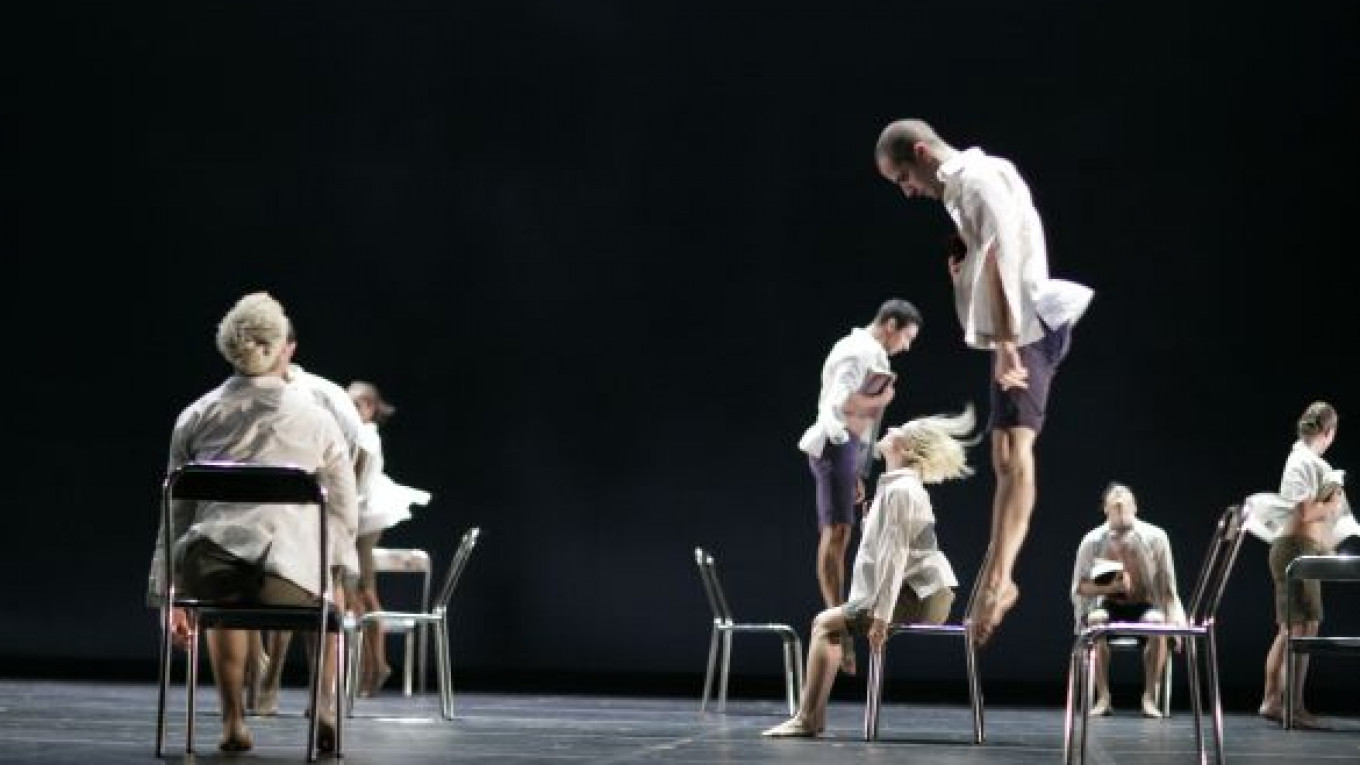The Bolshoi Theater’s 235th season got off to a highly unusual start with the world premiere of a new ballet by the celebrated French choreographer Angelin Preljocaj, co-produced by the Bolshoi and the choreographer’s own Aix-en-Provence-based Ballet Preljocaj.
Titled “Creation 2010 — And Then One Thousand Years of Peace,” the ballet brought together 10 dancers from the Bolshoi — all but one of them (soloist Anastasia Meskova) drawn from the theater’s corps de ballet — and 11 from Preljocaj’s company. Rehearsals began in late spring and lasted throughout the summer, first in Aix and eventually in Moscow.
From all reports, the two sets of dancers found their collaboration an extremely rewarding experience, and their execution of Preljocaj’s unconventional choreography proved exemplary, with the Bolshoi’s classically-oriented contingent blending almost to perfection with Ballet Preljocaj’s highly experienced interpreters of contemporary dance.
As for “Creation 2010 …,” expectations ran high, given the acclaim Preljocaj has received not only for stagings with his own troupe, but also for his work with such prestigious companies as those of the Paris Opera, Teatro alla Scala in Milan and the New York City Ballet. And no doubt some local ballet enthusiasts anticipated something on the same high level of creativity displayed by Preljocaj at his troupe’s debut in Moscow, as part of the unfortunately short-lived Grand Pas festival, seven years ago.
But the new ballet proved disappointing. It is difficult to imagine any choreographer, even the most talented of all, successfully filling an unbroken stretch of nearly two hours with abstract dance. But that is precisely what Preljocaj attempted. On opening night, the obviously exhausted audience gave it all a very tepid reception. Two nights later, the greeting was a few degrees warmer, but seemed to be aimed more at the work of the dancers than that of the choreographer.
The ballet was originally called “Apocalypse.” But even with the less off-putting title under which it eventually appeared, it remained a dance representation of Preljocaj’s rather unorthodox interpretation of the Apocalypse, as described in the New Testament Book of Revelation. In a program note, the choreographer pointed out that “the very word Apocalypse (from the Greek apo: ‘to lift’ and calypsis: ‘veil’) evokes the idea of revealing, unveiling or highlighting elements that could be present in our world but are hidden from our eyes. It should evoke what is nestled in the innermost recesses of our existence, rather than [prophesying] … catastrophe, irreparable destruction or the imminent end of the world.”
Perhaps by viewing a few more performances some real connection might be found between that statement and what occurs on stage. In overall effect, the ballet seemed unfocused, with the choreographer simply throwing into it everything he could think of (including what appeared to be a row of kitchen sinks). And apart from several very well-crafted and quite erotic (in one case, audaciously homo-erotic) duets, there was very little that fit a normal definition of dance. Instead, a great deal of what passed for choreography amounted to a series of gymnastic-like exercises and a great deal of crawling about on the floor.
For music, decor and costumes, Preljocaj assembled what appeared on paper to be a crack team of collaborators. But much of the electronic score composed by famed French disc jockey Laurent Garnier seemed nothing more than random noise and wore out its welcome long before the curtain finally descended. The minimalist set by India’s leading installation artist, Subodh Gupta, consisted mainly of four box-like structures, moved about in various configurations and at one point mounted by male members of the cast in seeming imitation of a military drill. Russian designer Igor Chapurin, with four other Bolshoi ballet productions already to his credit, provided the costumes, all of which fit the mood of the ballet, though none could really be called an outstanding piece of design.
Following its run at the Bolshoi, “Creation 2010 …” is now on an extensive tour of Western Europe, which will include an appearance at Europe’s most prestigious dance festival, the Biennale de la Danse de Lyon, in France, and will come to an end in December with performances at the Palace of Versailles.
Following the tour, the ballet will be produced separately by both the Bolshoi and Ballet Preljocaj, with each company casting the work exclusively with its own dancers. How often it will actually reappear at the Bolshoi remains open to question. Most members of Moscow’s ballet audience are unlikely to wish to see it more than once. And it is almost certainly not the sort of ballet to which visitors to Moscow, on whom the Bolshoi much relies to fill its seats, are likely to flock.
Still, despite a less than successful outcome, the Bolshoi deserves great credit for its bold step in taking a chance on Preljocaj, as well as in allowing ten of its younger dancers to spend eight months immersing themselves in the world of contemporary ballet.
A Message from The Moscow Times:
Dear readers,
We are facing unprecedented challenges. Russia's Prosecutor General's Office has designated The Moscow Times as an "undesirable" organization, criminalizing our work and putting our staff at risk of prosecution. This follows our earlier unjust labeling as a "foreign agent."
These actions are direct attempts to silence independent journalism in Russia. The authorities claim our work "discredits the decisions of the Russian leadership." We see things differently: we strive to provide accurate, unbiased reporting on Russia.
We, the journalists of The Moscow Times, refuse to be silenced. But to continue our work, we need your help.
Your support, no matter how small, makes a world of difference. If you can, please support us monthly starting from just $2. It's quick to set up, and every contribution makes a significant impact.
By supporting The Moscow Times, you're defending open, independent journalism in the face of repression. Thank you for standing with us.
Remind me later.






